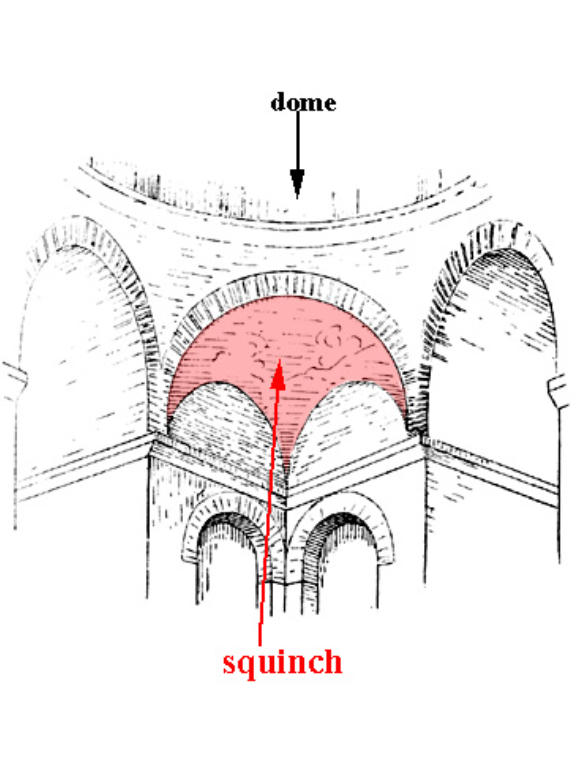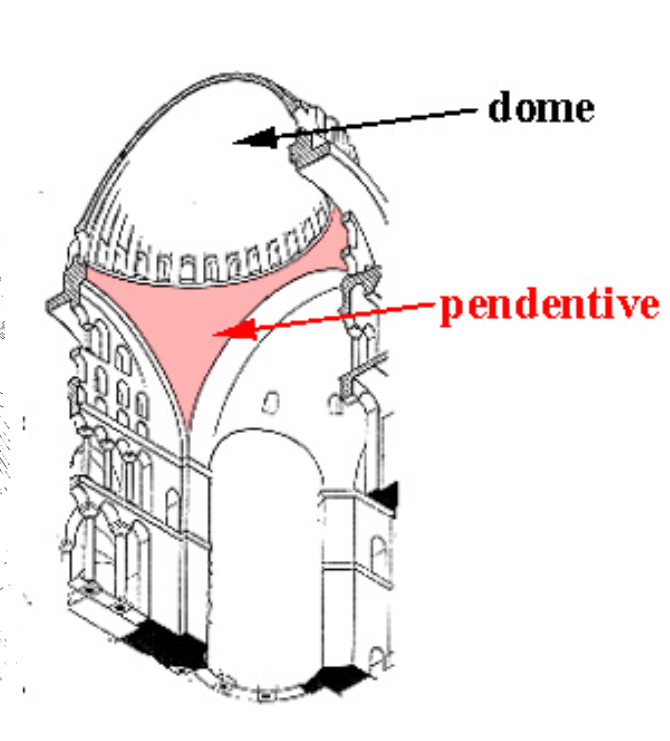Early Christian and Byzantine Terms
1/18
There's no tags or description
Looks like no tags are added yet.
Name | Mastery | Learn | Test | Matching | Spaced |
|---|
No study sessions yet.
19 Terms
Roman Emperor
Constantine, built Santa Costanza Mausoleum for his daughter.
Byzantine Art:
the art during the period of Constantine.
Basilica
large meeting hall, aisleless hall, divided by structural elements.
Narthex
Room at entrance.

Squinch
arched corbelling at the corner of a square room to support a dome.

Pendentive
The triangular shape at the corner to support a dome.
Mausoleum
Building made to hold a tomb.
Ambulatory
walking around a church
Impost
a column capitol shaped like an upside down pyramid.
Dosseret
a block placed above the column capitol to support the weight
Apse
the semi-circular room in basilica or Christian church.
Polykandelon
hanging fixture used to hold lamps and candles
Christian Symbols
peacock representing eternal life
fish representing Christianity, in general (from pagan symbolism)
good shepherd, an allegory (meaning from other than words, symbolic meaning) for a caring Christian, also an adaptation of a pagan figure bringing an offering to an altar
“monogram of Christ” combining the first two Greek letters in the name of Christ, chi & rho, resembling our X and P … the symbol superimposing one on the other, is called chi-rho
Human figures include: the four evangelists: Matthew, Mark, Luke, John … they were shown with wings early on, and then without. They were given different guises: Matthew depicted as a man, Mark as a lion, Luke as an ox, and John as an eagle … other symbols were taken from the Bible
Coptic Design
Design of Christianized Egypt … late 5th century to 640 after which Islamic forms dominated
Highly stylized, flat forms, pure and simple
Finding expression in: sculpture, bronze, glass, ivory, woodwork, wall paintings (frescoes) textiles and illuminated manuscripts
Celtic Design
(People who spoke the Celtic language) including: Irish, Welsh, parts of Scotland, isle of Man, Cornwall (British) & Brittany (French)
Origins Pagan … devise to accompany worship of complex grouping of pagan gods
Same artistic style applied to the new faith after conversion … influenced European monasteries founded by Irish missionaries
Plant forms, mythological beasts, human figures … highly abstract … most characteristic manifestation: knotwork … decorative motif in which tangles of linear elements are intricately interwoven
Celtic cross, (table 6-2)
Pottery, metal artifacts … chariot fittings, helmets, shields, spearheads, scabbards (sheath for holding a sword or knife), illuminated manuscripts
Polychrome Ware
ceramic piece with many colors and patterns
Summary
Covered together because the two coexisted and sometimes merged
Character …
Signs of classical world, in Byzantine: more signs of exotic Near East
Both design styles shared common goal: to herald triumph of Christianity and to manifest spirit of a supreme being and order in the universe
Quality
Early Christian design: more simple basic satisfaction of logical plans: basilica and centralized plans, sometimes built on impressive scale … spiritual world is evoked through the power of their ordered exteriors and ornate interiors … strength of these buildings diminished as their decoration increased and simple organization was obscured
Byzantine style, obscurity, expressed as a sense of mystery is a chief goal … that sense is enhanced as ornamentation proliferates. Spiritual world evoked through astonishment. The highest quality is in the ornament itself, color, minute/dazzling tesserae, carvings in wood, ivory, stone
Comparisons
Early Christian and Byzantine styles, as well as, Romanesque, Gothic, and Islamic styles occurred between the classical and Renaissance … these eras are distinguished by beauty achieved through exercise of logic and human accomplishment
Middle Ages … humans looked beyond this ordered and rational word to the spiritual realm. Their ideal became not worldly harmony, composure, and comprehension but the apprehension and exaltation of an otherworldly divine spirit.